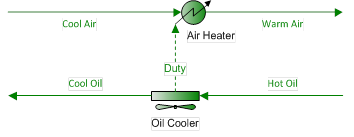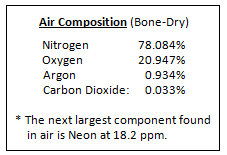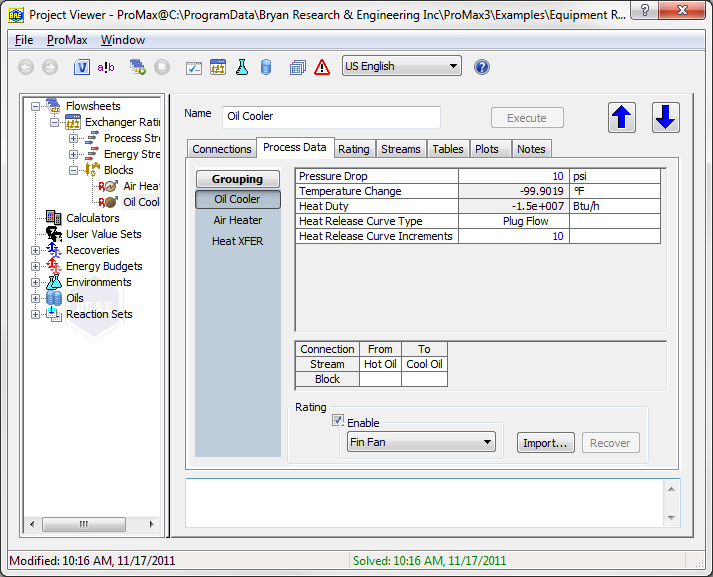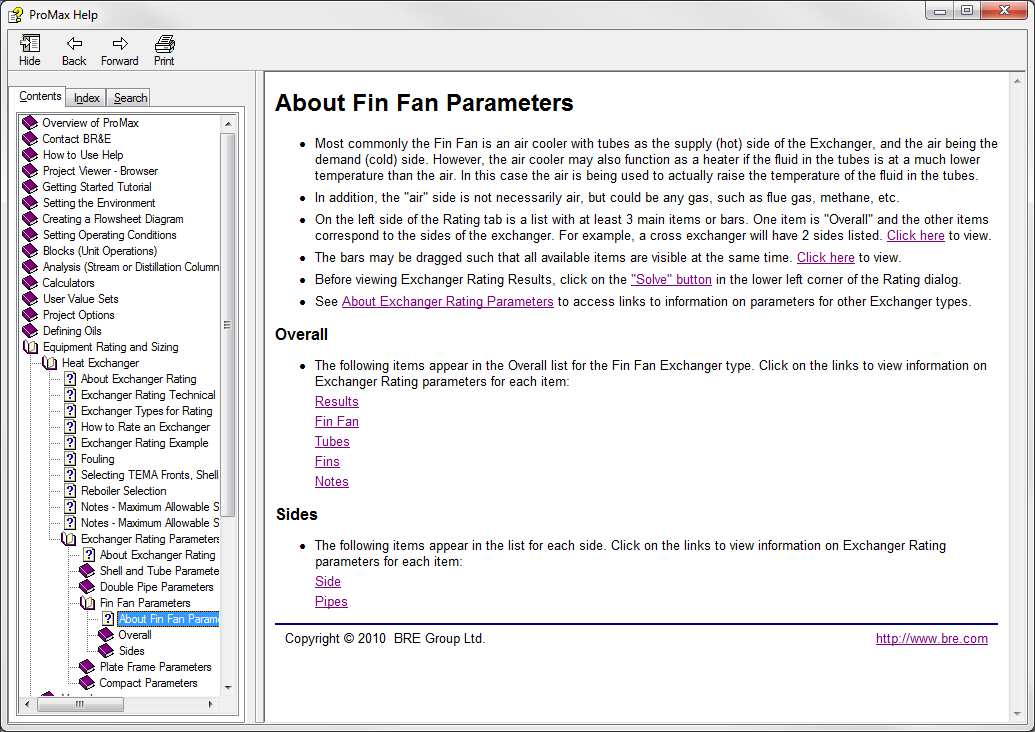Air Cooler Rating
Craig Spears
November 28, 2011
Preparing to Rate a Fin-Fan Exchanger in ProMax
ProMax can rate many types of exchanger, including fin-fan exchangers, but to do so the exchanger must be either a two-sided or multi-sided cross-exchanger. However, when utilizing the fin-fan shape included with ProMax, you are limited to a single-sided exchanger shape. This does not preclude you from being able to rate the air cooler and use the fin-fan shape, it just means that you must use two single-sided exchangers connected together by a common energy stream. You can see an example of this method being utilized in the picture below.

Also before the rating can be performed on the exchanger, it must be in a “solved” status, or colored green. This usually should include a pressure drop specification for each represented side of the heat exchanger. Assuming that the process side (represented by “Hot Oil” and “Cool Oil” streams in the illustration above) is already solved, the air side will also need to be specified. As with any other stream, temperature, pressure, flow rate, and composition must be given or calculated in some manner to turn green.
ProMax does not have an overly-simplistic option to set the composition of the air stream feeding the air cooler. The composition must be set as a mixture of components. Often an assumption of 79% Nitrogen and 21% Oxygen is utilized; occasionally a slightly improved 79% Nitrogen/21% Oxygen/1% Water mixture is used as well. The atmospheric temperature, pressure, and humidity have a very large impact on the actual composition of the air, however. On a bone-dry basis, the composition is:

The only other major component is water. At 100°F, fully-saturated air contains approximately 6.5% water. At 33°F, it only contains approximately 0.6% water if fully saturated. This difference will affect the heat exchange qualities of the air in the exchanger. Often for decent first-pass approximations, the above simplifications can be utilized. However, to obtain truly accurate exchanger ratings, the air composition should be as accurately represented as possible. The ProMax Saturator block will help give the correct water content if the atmospheric temperature, atmospheric pressure, and humidity level (percent saturation) are all specified.
After setting the temperature, pressure, and composition as suggested above, there is still another degree of freedom. This is often set as either the air flow rate through the exchanger (in which case the exiting air temperature will be calculated by the duty of the exchanger), or the exiting air temperature (in which case the air flow rate through the exchanger will be calculated by the duty).
Once both sides of the exchanger are solved, then the rating can be performed. The first step is to enable the rating from the Process Data tab found in the exchanger shape. Once the checkbox at the bottom is selected, then the type can be selected from the drop-down list. In this case I’ve selected the “Fin Fan” option.

Once the check-box is selected a “Rating” tab will appear. Selecting the correct type of exchanger from the drop-down list will refine the options found within the Rating tab to show what is applicable to the specific type of exchanger being rated. For instance, fan and bay information for a Fin Fan, shell information for a Shell & Tube, etc...
The number of increments can also be adjusted from this dialog. If the heat exchange is highly linear, then 5 to 10 increments are typically enough. If too large a percentage of heat exchange is occurring in a single increment, as occurs often with vaporizing or condensing conditions, ProMax will give a warning suggesting that the number of increments should be increased.
At this point, you should be ready to rate the exchanger. The ProMax Help has a considerable amount of information on placing all of the specific information into the “Bays”, “Tubes”, and “Fins” groupings. Once you have finished this, then you can “Solve” the rating. The “Results” grouping will give you some specific information on how the exchanger is expected to perform. If you have any difficulties, check the ProMax Help under “Fin Fan Exchanger Rating” where you can find more specific information, as shown below.
